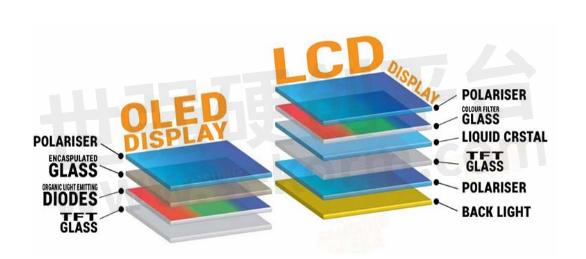The Difference and Advantages and Disadvantages of LCD Screen and OLED Screen

1. The difference between LCD screen and OLED screen:
LCD screen is a liquid crystal display technology, which controls the transmission and blocking of light through the twisting of liquid crystal molecules to display images. An OLED screen, on the other hand, is an organic light-emitting diode technology that displays images by emitting light from organic materials.

2. the advantages and disadvantages of OLED and LCD screens:
1. The advantages of OLED screens include:
(1) Better display: OLED screens can achieve higher contrast and more vivid colors because it can control the brightness and color of each pixel at the pixel level.
(2) More power-saving: OLED screens only emit light on the pixels that need to be displayed, so it can greatly reduce energy consumption when displaying black or dark images.
(3) Thinner and lighter: OLED screens do not require a backlight module, so they can be designed to be thinner and lighter.
2. The advantages of LCD screens include:
(1) Cheaper: LCD screens are cheaper to manufacture than OLED screens, so they are cheaper.
(2) More durable: LCD screens have a longer lifespan than OLED screens, because the organic materials of OLED screens will gradually degrade over time.
3. The disadvantages of OLED screens include:
(1) Display brightness is not as good as LCD screen: OLED screen is limited in display brightness because its light-emitting material will gradually degrade over time.
(2) Display images are prone to screen burn-in: OLED screens are prone to screen burn-in when displaying static images because the frequency of use of pixels is not balanced.
(3) High manufacturing cost: The manufacturing cost of OLED screens is higher than that of LCD screens because it requires more complex manufacturing processes and higher quality materials.
4. The disadvantages of LCD screens include:
(1) Limited viewing angle: The viewing angle of an LCD screen is limited because liquid crystal molecules can only distort light at a specific angle.
(2) High energy consumption: LCD screens require a backlight module to illuminate pixels, so energy consumption is high when displaying bright-color images.
(3) Slow response speed: The response speed of the LCD screen is slower than that of the OLED screen, so it is prone to afterimages when displaying fast-moving images.
Summary: LCD screens and OLED screens have their own advantages and disadvantages. You can consider what kind of product to use according to your own application scenarios and cost control factors. ALL VISION LCD focuses on LCD screens. If you have any needs in this regard, welcome to consult.
- +1 Like
- Add to Favorites
Recommend
- Four Advantages of 5.5 Inch LCD Screen
- 4.3 Inch LCD Screen Common Resolution and Its Application Industry
- 3.97 Inch LCD Application
- Technical Characteristics and Application Scenarios of 4.3-inch LCD Screen
- What Factors Affect the Price of 7-inch LCD Screens?
- 6.9inch Long LCD Screen FL070WX3-SP40-B03I with a Resolution of up to 280*1424 and High Brightness Display 800cd/m²
- Application Fields of Small Size LCD Displays
- What Details Should Be Paid Attention to When Selecting Small and Medium-sized LCD Display Screens?
This document is provided by Sekorm Platform for VIP exclusive service. The copyright is owned by Sekorm. Without authorization, any medias, websites or individual are not allowed to reprint. When authorizing the reprint, the link of www.sekorm.com must be indicated.





























































































































































































































































































































































































































































































































































































































































































































































































































































































